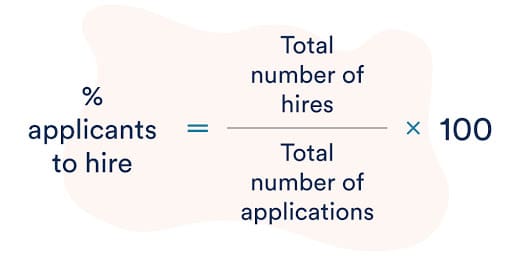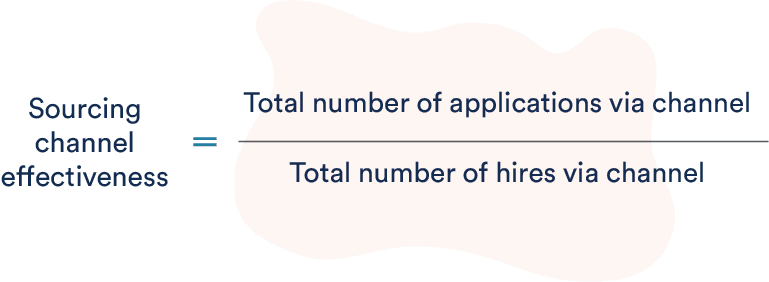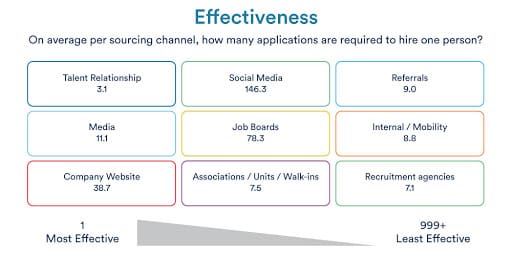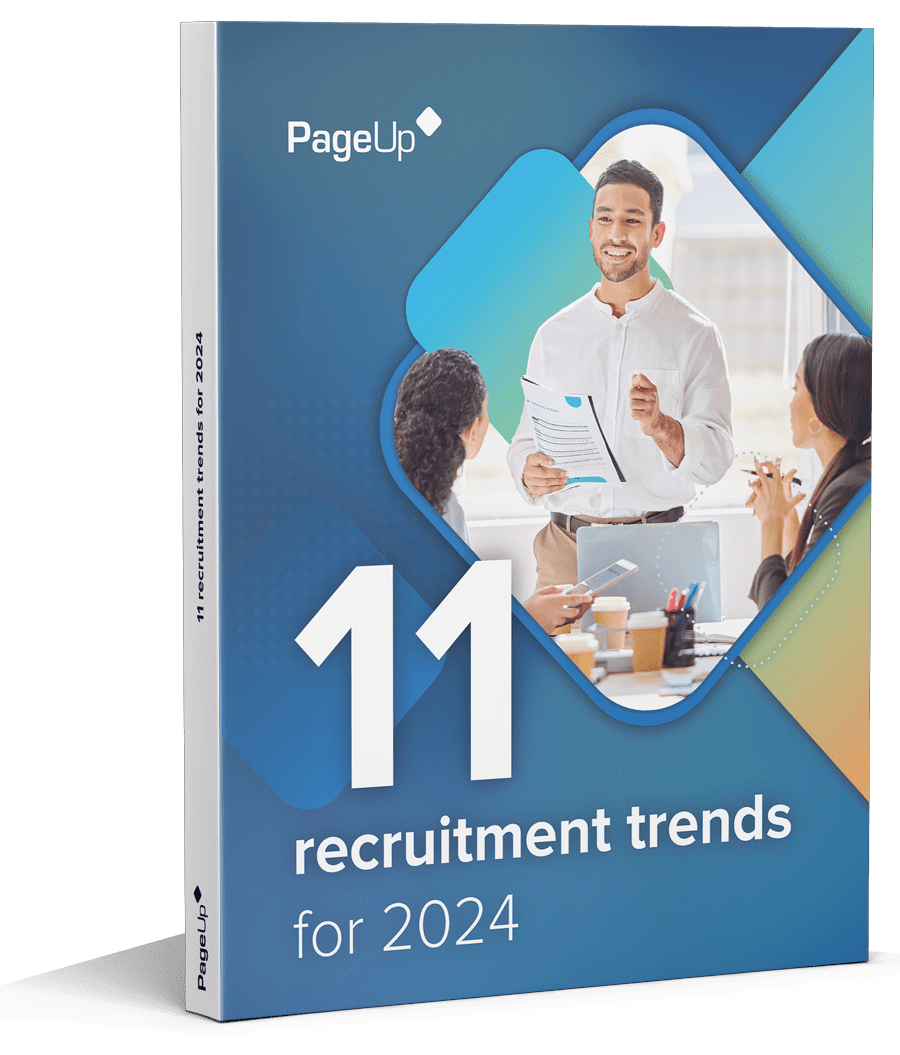Time to hire, cost to hire, quality of hire – we’ve all heard of these recruitment metrics before, should we be focusing on them? Time to hire and cost to hire may not offer the insights we’re after – at the end of the day we want the right person in the right role. Does it matter if it takes slightly longer or costs more? Quality of hire: that’s the ultimate goal. Unfortunately, measuring the quality of a hire during the recruitment process is difficult.
So what metrics should savvy HR practitioners be paying attention to? PageUp’s Head of Customer Insights & Market Research, Rebecca Skilbeck recently completed research into which recruitment metrics organisationsorganizations should focus on. She worked with organisationsorganizations to understand their hiring processes and identify which metrics were adding value – and which weren’t. Skilbeck’s research also uncovered proactive steps organisationsorganizations are taking to improve their hiring processes.
Here are the five recruitment metrics Rebecca identified that organisationsorganizations should be using.
1. Offer acceptance rate

You go to a lot of effort to find ‘the one’ – the candidate that is the right fit for your organisationorganization. They’ve been screened, interviewed, tested and background checked. They have the skills, experience, attitude and cultural alignment that you want. But do they want to work for you? You make the offer and… they accept (success!) or decline (what? why?).
Understanding and tracking your offer acceptance rate will help you understand what’s going on. “As talent acquisition professionals, knowing why it’s happening and what can be done about it is of real strategic value to your senior leadership team,” says Skilbeck.
PageUp research has found the average offer acceptance rate across industries is 94%. Top performing organisationsorganizations average 99% year-in, year-out. If your offer acceptance rate is less than 95% it’s worth reviewing the potential reasons why. Consider asking yourself:
- Are you an Employer of choice?
- Did something happen during the recruitment process?
- Are your benefits and compensation competitive?
- How do you rank against your competitors?
- Is your recruitment process fast enough to secure talent?
Is your offer acceptance rate acceptable?
To deep dive into the importance of offer acceptance rates, Skilbeck took talent acquisition professionals at two organisationsorganizations through their current rates of acceptance. The first team had an ‘aha!’ moment when they calculated a total of 112 declined offers year-to-date. This prompted a team brainstorm session to understand why the rate was so high, before they collaborated on ways to bring that number down in future.
The second organisationorganization initially felt that their offer acceptance rates were in line with their expectations. However, when their results were compared to the industry benchmark, not only did they rank below their industry – they also ranked below the average for all industries. Again, a quick brainstorm session helped the team identify three reasons for their low ranking, so that they could change their approach going forward.
Talent acquisition professionals often have an understanding of why candidates are not accepting an offer, but most don’t track it formally, and so can’t answer the question conclusively. It’s important to understand why this is happening and to start taking proactive steps to address the problem.
Your insights are only as good as the data
Another organisationorganization in Skilbeck’s research were experiencing phenomenally high offer acceptance rates. The team drilled down into why this was happening and quickly realisedrealized they were only progressing candidates to a formal offer after receiving a verbal acceptance. A great strategy in practice, but not so clever when they weren’t capturing verbal offer decline rates: thus skewing their offer acceptance rates. To get an accurate measure, it’s crucial to capture all of your data, from all sources.
Lifting your employer brand
If you feel you are not an employer of choice, you need to understand why. Often, it’s a case of improving your employer brand. As we know, to attract top talent it’s imperative to have a strong employer brand. If you don’t, it pays to investigate why, especially if there’s damaging consequences.
This was the case at another organisationorganization in Skilbeck’s research: past employees were leaving negative reviews of the company on Glassdoor. What steps did they take to improve their employer brand? By taking a creative approach and filming a ‘day-in-the-life’ of their employees. The stories were added to their careers site and social media pages to uplift their employer brand. This gave potential candidates a window into positive employee experiences, and helped detract from all of the negativity. And as Skilbeck reiterates from this organisationorganization’s experience, “Be proactive about sharing your employee experience on your careers site and online.”
“Be proactive about sharing your employee experience on your careers site and online.”
Location, location, location
Another organisationorganization in a remote, less-desirable location was faced with the challenge of attracting candidates. What was their approach to get people over the line? They went above just selling the current role: they sold candidates a future with the organisationorganization. An important takeaway from this scenario: “It pays to emphasise ongoing career opportunities as part of the recruitment process to attract candidates, not just to the current role, but their potential future career at that organisationorganization,” says Skilbeck.
Discuss salary early
Another learning was that during the application process, some organisationsorganizations found they were paying the standard wage, but were unable to compete on benefits. Candidates were progressing to the final offer stages without understanding the full remuneration and benefits package – then turning down offers if these were not in line with their expectations. This practice not only wasted valuable time and delivered a poor candidate experience, but also had the potential to damage the employer brand. “It’s crucial for candidates to understand salary and benefits early in the recruitment process,” explains Skilbeck.
Once you understand your offer acceptance rate and fill any gaps in your current processes, it’s important to track it over time to see how you’ve progressed.
2. Applicant-to-hire rate

How many applications do you need to find a qualified candidate? How many applications do you need to secure a hire? If you don’t have this data to hand, it’s easy to either leave positions open for longer than necessary or close them too early. Too many applicants can create unnecessary work, while too few can limit your ability to find the best people.
On average, for every 100 applications received, four people are hired (or 25 applications are needed for one hire), according to PageUp research. The exact numbers vary based on the industry: Higher Education hires 8% of applicants whereas Retail only hires 3% of applicants. Finance comes in at the overall average, 4%. What does this mean? If you find your organisationorganization’s metrics differ to the benchmark, ask yourself:
- Are you an employer of choice?
- If you are, a high volume of applications is to be expected.
- If you’re not, are your job ads targeted enough?
- Can you add a screening question at the start of the application form to remove non-valid applications?
- If you’re receiving a low volume of applications for a role, ask yourself whether your job ads are reaching and engaging the correct audience.
- Check wording for role description, bias, skill and competencies.
- Is your application form too long? Is it mobile optimisedoptimized?
- Is your careers site easy to navigate and engaging? Don’t underestimate the power of your careers website. This is where active and passive job seekers go to find out more about your organisationorganization.
- Do you need to improve your employer branding?
- Consider niche or additional job boards, career fairs, social media and referrals.
Feedback from organisationsorganizations in Skilbeck’s research highlighted that a frustrating candidate experience impacts the volume of applications. “It’s important to revamp your careers site – improve content, showcase your employer brand and simplify the online process to help increase the volume of applications,” says Skilbeck.
“It’s important to revamp your careers site – improve content, showcase your employer brand and simplify the online process to help increase the volume of applications.”
Testing shorter position openings
Another organisationorganization trialled shorter position opening times, with positive results. The volume of applications they received were lower, but the quality of applications and offer acceptance rate remained unchanged. The right candidates progressed to the next stages. It improved time to fill and hiring manager engagement as qualified candidates were presented much quicker. The success of this strategy was promptly demonstrated to the rest of the organisationorganization.
3. Candidates-to-hire rate

Applicants include everyone that has applied for the role, regardless of whether or not their experience, skills or behaviours match the requirements. As you move further down the recruitment funnel, non-suitable applicants are screened, leaving candidates that match the role requirements and have the experience, skills and behaviours that indicate they may be a good fit for the organisationorganization.

Out of this pool of potential candidates an average of 9% successfully land the job, according to PageUp research. These figures vary from industry to industry: Higher Education hires 19% of these qualified candidates, whereas Retail only hires 7%. Finance comes in closer to the overall average at 10%. This means nine candidates out of 100 are hired and 91 are unsuccessful.
Having a high volume of unsuccessful candidates can potentially impact your employer brand: maintaining a high-touch approach and adequate candidate care is difficult across large cohorts. What’s more, taking high volumes of candidates through recruitment activities is costly and labour intensive. A robust screening process that identifies highly suitable candidates early on is crucial to cut down the time and cost to hire.
“Having a high volume of unsuccessful candidates can potentially impact your employer brand: maintaining a high-touch approach and adequate candidate care is difficult across large cohorts.”
Solving critical business issues
When we asked organisationsorganizations about the key business problems they were trying to solve and how they measured success, a number of themes emerged:
- Finding and attracting talent
- The candidate experience (and minimising brand damage)
- Hiring manager engagement (simple, streamlined processes)
- Being an employer of choice (how to build and maintain employer brand)
- Hard to fill roles
- Insufficient volumes of candidates or the opposite: large volumes of candidates and the lack of proper management method.
The most common pain point across the board was finding talent quickly. Some tactics organisationsorganizations who successfully find talent quickly include:
- Using recruitment marketing
- Keeping talent pools warm
- Implementing a continuous pipelining strategy
Effective use of talent pools and engaging ‘silver medallists’
What’s the value of a talent pool? One organisationorganization found they were not using their talent pools effectively. This prompted them to think about those ‘silver medallist’ candidates – the second-in-line candidates who just missed out on a role. It’s imperative to keep highly-qualified candidates in talent pools and nurtured. The team discussed how this practice could save them time and money when it came time for the next round of recruiting. PageUp research shows only 43% of organisationsorganizations have well-established talent pools to meet the future needs of their company.
4. Sourcing channel effectiveness

Where do the best quality candidates come from? Being able to answer this question is vital to optimising sourcing efforts. Understanding the most effective source of talent for your organisationorganization ensures the best ROI on recruitment time and financial investment. Knowing this information helps you create targeted, results-driven recruitment campaigns.
When asked about the most effective sourcing channels, most of the organisationsorganizations Skilbeck spoke with felt they were lacking knowledge. There is a difference between knowing where your applications come from and knowing how effective each channel is. PageUp research has found that 26% of applications and 17% of hires come via a company’s careers website. Even though only 3% of applications come from employee referrals, these applications account for 9% of a company’s overall hires. That means employee referral is 4.3 times more effective in finding suitable hires than a company’s career website.
“Employee referral is 4.3 times more effective in finding suitable hires than a company’s career website.”
Interpreting sourcing channel effectiveness requires reliable metrics and context. Someone who first hears about a role through social media may be less suitable than a job seeker who already works at the organisationorganization or a referral. Although referral and internal candidates are higher quality, they’re not always available, so a mix of channels is required.

5. Mobile applications and time to apply rates


Mobile applications and time to apply rates are two separate metrics, but they work together to tell a story that might otherwise be overlooked. There are several converging trends driving the adoption of mobile-optimisedoptimized recruitment.
- Demographics are changing: baby boomers are retiring and millennials will make up 50% of the workforce by 2020.
- Smartphone adoption rates amongst casual, remote and blue collar workers are increasing.
- People are demanding a consumer experience at work. There’s pressure on technology to deliver seamless connectivity for everything, including social and mobile.
In response, many organisationsorganizations have optimisedoptimized their careers websites and recruitment processes to be compatible with mobile devices. But are you measuring the uptake of mobile functionality? If it’s lower than expected, do you understand why?
In the past year, according to PageUp research, 19% of applications were submitted via a mobile device. That’s up from 15% at the end of 2017, and notably higher than the external benchmark of 16%. PageUp research has also found that there is a correlation between abandoned job applications and applications made on a mobile device. As the application form lengthens, the number of incomplete applications via mobile devices increases. Lengthy job applications become tedious on these devices, applicants give up and they don’t complete the application. This doesn’t happen as often on desktop.
If you’re looking to optimiseoptimize your mobile recruitment approaches, make it simple and easy for jobseekers to apply on-the-go. Consider:
- Allowing candidates to attach their resume or autofill applications from their social media profiles (saving time to manually fill in employment information).
- Enabling desktop-standard search and application functionality from mobile devices.
Candidates expect to search and apply for jobs from their mobile devices. This is especially important in industries that have low desktop usage like Retail, Healthcare, Mining, and Manufacturing. If jobseekers find the application process frustrating, they may choose another employer who matches their technology expectations.
Ensuring you collect and analyse the data you need to measure these five often overlooked metrics can save your organisationorganization significant time and money and help you attract the best talent for your organisationorganization.
Fresh insights for HR
Stay up to date with HR trends, tips and more when you sign up for our industry newsletter







